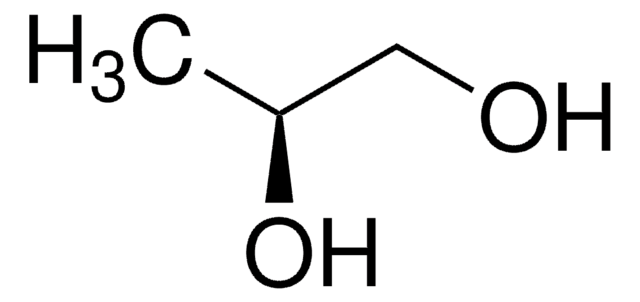16033
1,2-Propanediol
meets analytical specification of Ph. Eur., BP, USP, ≥99.5%
Sinónimos:
1,2-PDO, Propylene glycol
About This Item
Productos recomendados
vapor density
2.62 (vs air)
Quality Level
vapor pressure
0.08 mmHg ( 20 °C)
assay
≥99.5%
form
liquid
autoignition temp.
779 °F
quality
meets analytical specification of Ph. Eur., BP, USP
shelf life
24 mo.
expl. lim.
12.5 %
impurities
acidic reac. impurities, complies
organic volatile impurities, complies (GC)
oxidizing substances, complies
reducing matter, complies
residual solvents, complies
≤0.0005% heavy metals (as Pb)
≤0.002% free alkali (as NaOH)
≤0.003% free acid (as CH3COOH)
≤0.2% water (Karl Fischer)
ign. residue
≤0.005% (as SO4)
refractive index
n20/D 1.431-1.433
n20/D 1.432 (lit.)
bp
187 °C (lit.)
mp
−60 °C (lit.)
density
1.036 g/mL at 25 °C (lit.)
anion traces
chloride (Cl-): ≤50 mg/kg
sulfate (SO42-): ≤50 mg/kg
suitability
complies for appearance of solution
functional group
hydroxyl
SMILES string
CC(O)CO
InChI
1S/C3H8O2/c1-3(5)2-4/h3-5H,2H2,1H3
InChI key
DNIAPMSPPWPWGF-UHFFFAOYSA-N
¿Está buscando productos similares? Visita Guía de comparación de productos
General description
Application
Packaging
Other Notes
The article number 16033-6X1L will be discontinued. Please order the single bottle 16033-1L which is physically identical with the same exact specifications.
The article number 16303-4X2.5L-R will be discontinued. Please order the single bottle 16303-2.5L-R which is physically identical with the same exact specifications.
Storage Class
10 - Combustible liquids
wgk_germany
WGK 1
flash_point_f
219.2 °F - closed cup
flash_point_c
104 °C - closed cup
ppe
Eyeshields, Gloves
Elija entre una de las versiones más recientes:
¿Ya tiene este producto?
Encuentre la documentación para los productos que ha comprado recientemente en la Biblioteca de documentos.
Los clientes también vieron
Chromatograms
suitable for GCsuitable for GCNuestro equipo de científicos tiene experiencia en todas las áreas de investigación: Ciencias de la vida, Ciencia de los materiales, Síntesis química, Cromatografía, Analítica y muchas otras.
Póngase en contacto con el Servicio técnico





